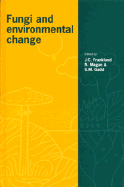Book contents
- Frontmatter
- Contents
- List of contributors
- Preface
- 1 Effects of climate change on fungal diseases of trees
- 2 Effects of climate change on Fusarium foot rot of winter wheat in the United Kingdom
- 3 Effects of UV-B radiation (280–320 nm) on foliar saprotrophs and pathogens
- 4 Implications of global warming and rising sea-levels for macrofungi in UK dune systems
- 5 Red Data Lists and decline in fruiting of macromycetes in relation to pollution and loss of habitat
- 6 Effects of dry-deposited SO2 and sulphite on saprotrophic fungi and decomposition of tree leaf litter
- 7 Effects of atmospheric pollutants on phyllosphere and endophytic fungi
- 8 Influences of acid mist and ozone on the fluorescein diacetate activity of leaf litter
- 9 Mycorrhizas and environmental stress
- 10 Myccorhizas, succession, and the rehabilitation of deforested lands in the humid tropics
- 11 Potential effects on the soil mycoflora of changes in the UK agricultural policy for upland grasslands
- 12 Uptake and immobilization of caesium in UK grassland and forest soils by fungi, following the Chernobyl accident
- 13 Effects of pollutants on aquatic hyphomycetes colonizing leaf material in freshwaters
- 14 Fungi and salt stress
- 15 Fungal sequestration, mobilization and transformation of metals and metalloids
- 16 Urban, industrial and agricultural effects on lichens
- 17 Fungal interactions with metals and radionuclides for environmental bioremediation
- 18 Impact of genetically-modified microorganisms on the terrestrial microbiota including fungi
- 19 Has chaos theory a place in environmental mycology?
- Index of generic and specific names
- Subject index
11 - Potential effects on the soil mycoflora of changes in the UK agricultural policy for upland grasslands
Published online by Cambridge University Press: 05 November 2011
- Frontmatter
- Contents
- List of contributors
- Preface
- 1 Effects of climate change on fungal diseases of trees
- 2 Effects of climate change on Fusarium foot rot of winter wheat in the United Kingdom
- 3 Effects of UV-B radiation (280–320 nm) on foliar saprotrophs and pathogens
- 4 Implications of global warming and rising sea-levels for macrofungi in UK dune systems
- 5 Red Data Lists and decline in fruiting of macromycetes in relation to pollution and loss of habitat
- 6 Effects of dry-deposited SO2 and sulphite on saprotrophic fungi and decomposition of tree leaf litter
- 7 Effects of atmospheric pollutants on phyllosphere and endophytic fungi
- 8 Influences of acid mist and ozone on the fluorescein diacetate activity of leaf litter
- 9 Mycorrhizas and environmental stress
- 10 Myccorhizas, succession, and the rehabilitation of deforested lands in the humid tropics
- 11 Potential effects on the soil mycoflora of changes in the UK agricultural policy for upland grasslands
- 12 Uptake and immobilization of caesium in UK grassland and forest soils by fungi, following the Chernobyl accident
- 13 Effects of pollutants on aquatic hyphomycetes colonizing leaf material in freshwaters
- 14 Fungi and salt stress
- 15 Fungal sequestration, mobilization and transformation of metals and metalloids
- 16 Urban, industrial and agricultural effects on lichens
- 17 Fungal interactions with metals and radionuclides for environmental bioremediation
- 18 Impact of genetically-modified microorganisms on the terrestrial microbiota including fungi
- 19 Has chaos theory a place in environmental mycology?
- Index of generic and specific names
- Subject index
Summary
Introduction
Hill and upland areas, defined as land typically above 150 m altitude, within designated agriculturally less favoured areas, and composed predominately of dwarf shrub heaths, grassland and peat bogs, make up more than one-third (5.8 M ha) of the total UK land surface (Ratcliffe & Thompson, 1988). Agriculture, in particular sheep farming, is the primary industry of such hill and upland areas, and its expansion over the last seven–eight centuries has resulted in the development of vast areas of sheep walk composed of indigenous Agrostis-Festuca, Nardus and Molinia dominant grassland. These indigenous grasslands or rough grazings presently constitute some 70% of the land within the hills and uplands (Newbould, 1985).
Traditionally, indigenous hill grasslands have been lightly grazed by pure bred sheep. Over the last few decades, however, intensities of sheep farming have increased dramatically, due largely to improvements in grassland productivity from use of fertilizer and lime. These agricultural improvements have caused considerable concern amongst conservationists, particularly for the loss of indigenous flora and fauna of the hills and uplands (Sydes & Miller, 1988; Bardgett & Marsden, 1992; Bardgett, Marsden & Howard, 1995). Recent changes in UK agricultural policy have reflected these concerns and addressed others, such as the overproduction of meat. Consequent reductions in financial subsidies based on output, and the introduction of monetary incentives for hill farmers to manage their land in such a way as to preserve or improve the environment (for example, environmentally sensitive areas) are likely to result in an overall reduction in liming and the use of fertilizer, and hence of the intensity of sheep grazing on upland grasslands.
- Type
- Chapter
- Information
- Fungi and Environmental Change , pp. 163 - 183Publisher: Cambridge University PressPrint publication year: 1996
- 6
- Cited by

